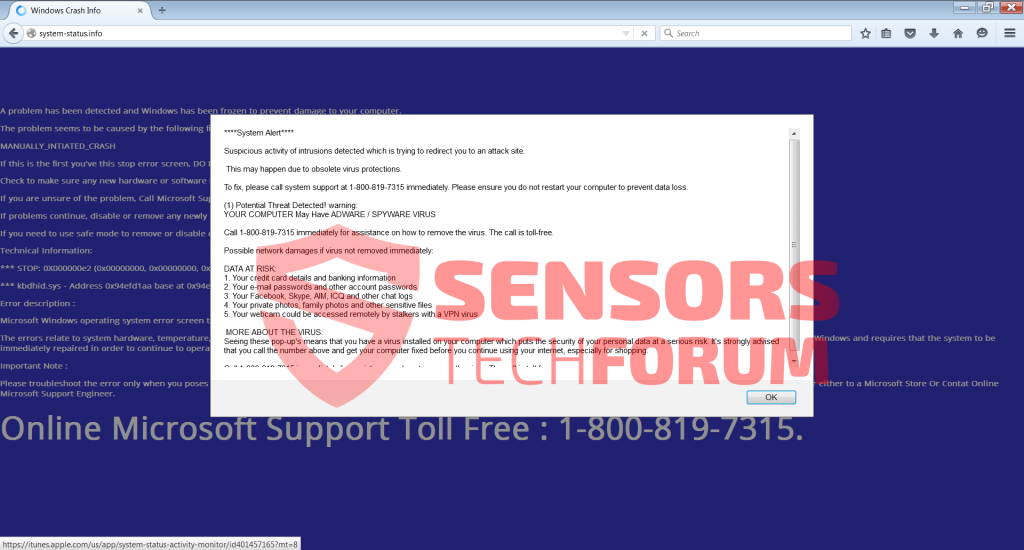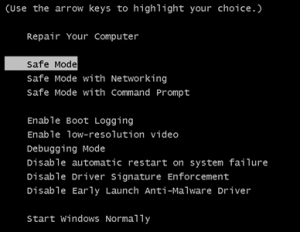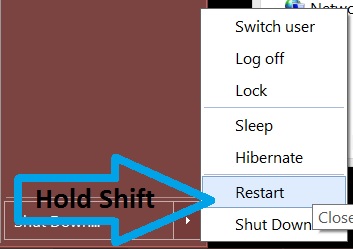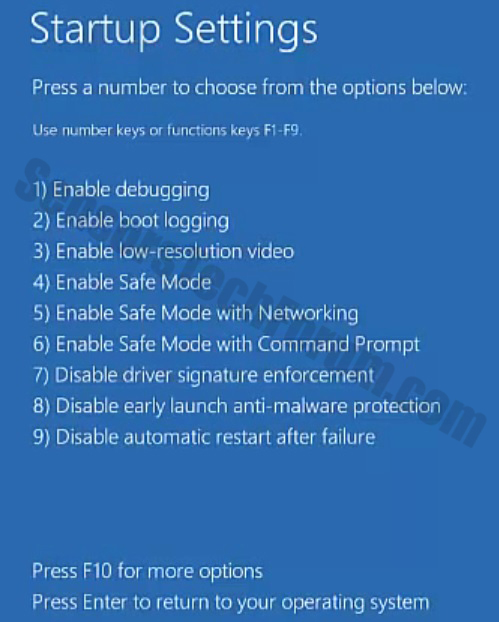| Name | System-Status.Info |
| Type | Tech Support Scam, PUP |
| Short Description | Aims to deceive users into believing that their system is infected. Features a phone number. |
| Symptoms | Background imitating a legitimate Microsoft Windows BSOD screen with pop-ups claiming that users must call a number to remove viruses on their computer. |
| Distribution Method | Freeware installers, Visiting suspicious websites, Browser Redirects. |
| Detection Tool | Download Malware Removal Tool, to See If Your System Has Been Affected by malware |
| User Experience | Join our forum to discuss about System-Status.Info. |
“System-status.info” is a domain of a Fake Tech Support website; but it can also have a browser extension or a Potentially Unwanted Program (PUP) installed on the victim’s PC. The user may be constantly redirected to the domain and unable to get out of the domain or browser. There are also pop-ups that support the scam, claiming that the user is infected with viruses and in order to prevent data loss, the user must call a “toll-free” phone number.
System-status.info – How Did I Get It?
The PUP and/or browser extension that support the “System-status.info” domain usually get into your computer via third-party installers. They can sneak into your computer without your consent, by concealing themselves in freeware installations and bundled packages.
In these packages, additional components for installation are not always disclosed properly, and people get tricked into installing potentially unwanted programs such as those related to “System-status.info”. Sometimes that can be avoided by clicking on the “Advanced” or “Custom” option in an installation setup to see what will be installed.
Other ways of getting infected are by opening spam emails and downloading e-mail attachments, or by clicking on various ads and banners containing malicious content.
System-status.info – More About It
“System-status.info” is a malicious domain of a fake tech support website. It claims that your computer is infected with adware and spyware and to be able to remove them you have to “immediately” call the “Microsoft Support Toll-Free” phone number “1-800-819-7315”. On top of that an audio file is instantly played on the main site, with the voice of a woman telling you an “Important security message – call this number immediately, because your personal data is at a serious risk!”.
The truth is that this may be the most expensive call in your life. It is definitely not free, and it will cost a lot of money per impulse. That is not the only reason you should NOT in any circumstances call the fake support number – the scammers that run the website, may also try to get you to tell them personal details and financial information using different tricky techniques. Then they can sell that data to the highest bidder or take advantage of it themselves according to their interests.
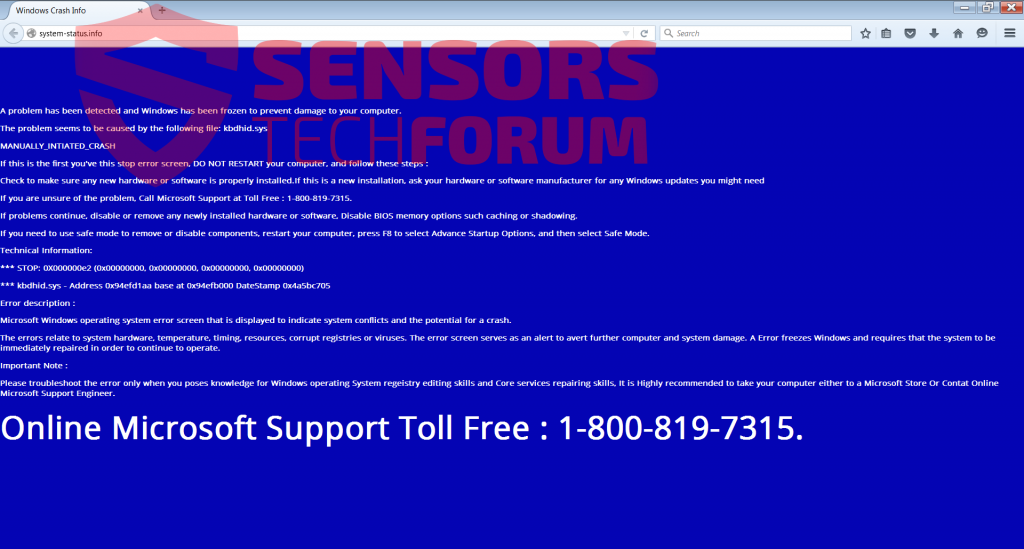
Another interesting thing on the site is that you are advised not to restart your computer, and the fake Blue Screen of Death (BSOD) is just a blue background with a custom text written in white. But you may not be able to figure it out, due to the constant windows that keep popping up. Everything is done in a matter to scare you and for you to rush in and abide by the site’s rules and you to give money to the scammers in the ways described above.
“System-status.info” may also collect information about you via cookies and custom Java Script files injected through the browser extension or a program installed on your PC that is assisting the fake support site.
Remove System-status.info Fully from Your PC
To remove “System-status.info” manually from your computer, make sure to follow the step-by-step removal instructions provided below. In case the manual removal does not get rid of the browser redirects and PUPs completely, you should search for and remove the leftovers with an advanced anti-malware program. Installing such a program will also make certain that your system is secure from other threats you may encounter.
In order to completely be rid of this tech support scamming site you should follow these steps:
For Google Chrome
Step 1
Right-click on the Chrome icon in your taskbar and then click on ‘New Incognito Window’. This will disable any webpages running on startup.
Step 2
In the address bar type chrome://settings/resetProfileSettings in the address bar and click on ‘Reset’.
For Mozilla Firefox
Step 1
Open Mozilla Firefox by right-clicking on its icon in the taskbar and licking New Private Window.
Step 2
In the address bar type about:support. Then click on ‘Refresh Firefox’ and accept the prompt from Firefox to save your old data on your desktop so you can easily access it.
For Internet Explorer
Step 1
Right-click on the Internet Explorer icon in your taskbar and click on Start In-Private Browsing.
Step 2
Click on the gear leaver icon in the top right and from the drop-down menu click on Internet Options.
Step 3
Go to the Advanced Tab and then click on the ‘Reset’ button.
For Safari
Step 1
Open Safari and click on the gear leaver icon.
Step 2
From the drop-down menu click on the Reset Safari button and you should be fine.
Also, in case you received this pop-up as a redirect (it suddenly opened) there is a good chance that it may have been done by an adware program or a browser hijacker on your computer. The worst case scenario may be if you have been redirected via a Trojan.Clicker – spyware that visits sites on your behalf. In order to detect and remove such programs, make sure that you boot into safe mode and scan your computer. On way to do this is to follow these steps:
Step 1: Start Your PC in Safe Mode to Remove System-Status.Info.
Removing System-Status.Info from Windows XP, Vista, 7 systems:
1. Remove all CDs and DVDs, and then Restart your PC from the “Start” menu.
2. Select one of the two options provided below:
– For PCs with a single operating system: Press “F8” repeatedly after the first boot screen shows up during the restart of your computer. In case the Windows logo appears on the screen, you have to repeat the same task again.
– For PCs with multiple operating systems: Тhe arrow keys will help you select the operating system you prefer to start in Safe Mode. Press “F8” just as described for a single operating system.
3. As the “Advanced Boot Options” screen appears, select the Safe Mode option you want using the arrow keys. As you make your selection, press “Enter“.
4. Log on to your computer using your administrator account
While your computer is in Safe Mode, the words “Safe Mode” will appear in all four corners of your screen.
Removing System-Status.Info from Windows 8, 8.1 and 10 systems:
Substep 1:
Substep 2:
Whilst holding down Shift button, click on Power and then click on Restart.
Substep 3:
After reboot, the aftermentioned menu will appear. From there you should choose Troubleshoot.
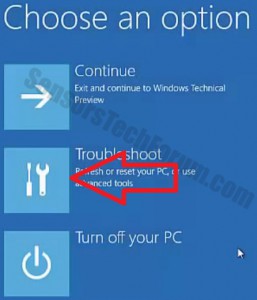
Substep 4:
You will see the Troubleshoot menu. From this menu you can choose Advanced Options.
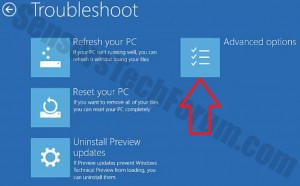
Substep 5:
After the Advanced Options menu appears, click on Startup Settings.
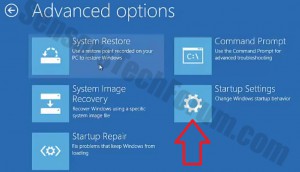
Substep 6:
Substep 7:
A menu will appear upon reboot. You should choose Safe Mode by pressing its corresponding number and the machine will restart and boot into Safe Mode so you can scan for and remove System-Status.Info.
Step 2: Remove System-Status.Info automatically by downloading an advanced anti-malware program.
To clean your computer you should download an updated anti-malware program on a safe PC and then install it on the affected computer in offline mode. After that you should boot into safe mode and scan your computer to remove all System-Status.Info associated objects.

Spy Hunter scanner will only detect the threat. If you want the threat to be automatically removed, you need to purchase the full version of the anti-malware tool.Find Out More About SpyHunter Anti-Malware Tool / How to Uninstall SpyHunter
- Windows
- Mac OS X
- Google Chrome
- Mozilla Firefox
- Microsoft Edge
- Safari
- Internet Explorer
- Stop Push Pop-ups
How to Remove System-Status.Info from Windows.
Step 1: Scan for System-Status.Info with SpyHunter Anti-Malware Tool



Step 2: Boot Your PC In Safe Mode





Step 3: Uninstall System-Status.Info and related software from Windows
Here is a method in few easy steps that should be able to uninstall most programs. No matter if you are using Windows 10, 8, 7, Vista or XP, those steps will get the job done. Dragging the program or its folder to the recycle bin can be a very bad decision. If you do that, bits and pieces of the program are left behind, and that can lead to unstable work of your PC, errors with the file type associations and other unpleasant activities. The proper way to get a program off your computer is to Uninstall it. To do that:


 Follow the instructions above and you will successfully uninstall most programs.
Follow the instructions above and you will successfully uninstall most programs.
Step 4: Clean Any registries, Created by System-Status.Info on Your PC.
The usually targeted registries of Windows machines are the following:
- HKEY_LOCAL_MACHINE\Software\Microsoft\Windows\CurrentVersion\Run
- HKEY_CURRENT_USER\Software\Microsoft\Windows\CurrentVersion\Run
- HKEY_LOCAL_MACHINE\Software\Microsoft\Windows\CurrentVersion\RunOnce
- HKEY_CURRENT_USER\Software\Microsoft\Windows\CurrentVersion\RunOnce
You can access them by opening the Windows registry editor and deleting any values, created by System-Status.Info there. This can happen by following the steps underneath:


 Tip: To find a virus-created value, you can right-click on it and click "Modify" to see which file it is set to run. If this is the virus file location, remove the value.
Tip: To find a virus-created value, you can right-click on it and click "Modify" to see which file it is set to run. If this is the virus file location, remove the value.
Video Removal Guide for System-Status.Info (Windows).
Get rid of System-Status.Info from Mac OS X.
Step 1: Uninstall System-Status.Info and remove related files and objects





Your Mac will then show you a list of items that start automatically when you log in. Look for any suspicious apps identical or similar to System-Status.Info. Check the app you want to stop from running automatically and then select on the Minus (“-“) icon to hide it.
- Go to Finder.
- In the search bar type the name of the app that you want to remove.
- Above the search bar change the two drop down menus to “System Files” and “Are Included” so that you can see all of the files associated with the application you want to remove. Bear in mind that some of the files may not be related to the app so be very careful which files you delete.
- If all of the files are related, hold the ⌘+A buttons to select them and then drive them to “Trash”.
In case you cannot remove System-Status.Info via Step 1 above:
In case you cannot find the virus files and objects in your Applications or other places we have shown above, you can manually look for them in the Libraries of your Mac. But before doing this, please read the disclaimer below:



You can repeat the same procedure with the following other Library directories:
→ ~/Library/LaunchAgents
/Library/LaunchDaemons
Tip: ~ is there on purpose, because it leads to more LaunchAgents.
Step 2: Scan for and remove System-Status.Info files from your Mac
When you are facing problems on your Mac as a result of unwanted scripts and programs such as System-Status.Info, the recommended way of eliminating the threat is by using an anti-malware program. SpyHunter for Mac offers advanced security features along with other modules that will improve your Mac’s security and protect it in the future.
Video Removal Guide for System-Status.Info (Mac)
Remove System-Status.Info from Google Chrome.
Step 1: Start Google Chrome and open the drop menu

Step 2: Move the cursor over "Tools" and then from the extended menu choose "Extensions"

Step 3: From the opened "Extensions" menu locate the unwanted extension and click on its "Remove" button.

Step 4: After the extension is removed, restart Google Chrome by closing it from the red "X" button at the top right corner and start it again.
Erase System-Status.Info from Mozilla Firefox.
Step 1: Start Mozilla Firefox. Open the menu window:

Step 2: Select the "Add-ons" icon from the menu.

Step 3: Select the unwanted extension and click "Remove"

Step 4: After the extension is removed, restart Mozilla Firefox by closing it from the red "X" button at the top right corner and start it again.
Uninstall System-Status.Info from Microsoft Edge.
Step 1: Start Edge browser.
Step 2: Open the drop menu by clicking on the icon at the top right corner.

Step 3: From the drop menu select "Extensions".

Step 4: Choose the suspected malicious extension you want to remove and then click on the gear icon.

Step 5: Remove the malicious extension by scrolling down and then clicking on Uninstall.

Remove System-Status.Info from Safari
Step 1: Start the Safari app.
Step 2: After hovering your mouse cursor to the top of the screen, click on the Safari text to open its drop down menu.
Step 3: From the menu, click on "Preferences".

Step 4: After that, select the 'Extensions' Tab.

Step 5: Click once on the extension you want to remove.
Step 6: Click 'Uninstall'.

A pop-up window will appear asking for confirmation to uninstall the extension. Select 'Uninstall' again, and the System-Status.Info will be removed.
Eliminate System-Status.Info from Internet Explorer.
Step 1: Start Internet Explorer.
Step 2: Click on the gear icon labeled 'Tools' to open the drop menu and select 'Manage Add-ons'

Step 3: In the 'Manage Add-ons' window.

Step 4: Select the extension you want to remove and then click 'Disable'. A pop-up window will appear to inform you that you are about to disable the selected extension, and some more add-ons might be disabled as well. Leave all the boxes checked, and click 'Disable'.

Step 5: After the unwanted extension has been removed, restart Internet Explorer by closing it from the red 'X' button located at the top right corner and start it again.
Remove Push Notifications from Your Browsers
Turn Off Push Notifications from Google Chrome
To disable any Push Notices from Google Chrome browser, please follow the steps below:
Step 1: Go to Settings in Chrome.

Step 2: In Settings, select “Advanced Settings”:

Step 3: Click “Content Settings”:

Step 4: Open “Notifications”:

Step 5: Click the three dots and choose Block, Edit or Remove options:

Remove Push Notifications on Firefox
Step 1: Go to Firefox Options.

Step 2: Go to “Settings”, type “notifications” in the search bar and click "Settings":

Step 3: Click “Remove” on any site you wish notifications gone and click “Save Changes”

Stop Push Notifications on Opera
Step 1: In Opera, press ALT+P to go to Settings.

Step 2: In Setting search, type “Content” to go to Content Settings.

Step 3: Open Notifications:

Step 4: Do the same as you did with Google Chrome (explained below):

Eliminate Push Notifications on Safari
Step 1: Open Safari Preferences.

Step 2: Choose the domain from where you like push pop-ups gone and change to "Deny" from "Allow".
System-Status.Info-FAQ
What Is System-Status.Info?
The System-Status.Info threat is adware or browser redirect virus.
It may slow your computer down significantly and display advertisements. The main idea is for your information to likely get stolen or more ads to appear on your device.
The creators of such unwanted apps work with pay-per-click schemes to get your computer to visit risky or different types of websites that may generate them funds. This is why they do not even care what types of websites show up on the ads. This makes their unwanted software indirectly risky for your OS.
What Are the Symptoms of System-Status.Info?
There are several symptoms to look for when this particular threat and also unwanted apps in general are active:
Symptom #1: Your computer may become slow and have poor performance in general.
Symptom #2: You have toolbars, add-ons or extensions on your web browsers that you don't remember adding.
Symptom #3: You see all types of ads, like ad-supported search results, pop-ups and redirects to randomly appear.
Symptom #4: You see installed apps on your Mac running automatically and you do not remember installing them.
Symptom #5: You see suspicious processes running in your Task Manager.
If you see one or more of those symptoms, then security experts recommend that you check your computer for viruses.
What Types of Unwanted Programs Are There?
According to most malware researchers and cyber-security experts, the threats that can currently affect your device can be rogue antivirus software, adware, browser hijackers, clickers, fake optimizers and any forms of PUPs.
What to Do If I Have a "virus" like System-Status.Info?
With few simple actions. First and foremost, it is imperative that you follow these steps:
Step 1: Find a safe computer and connect it to another network, not the one that your Mac was infected in.
Step 2: Change all of your passwords, starting from your email passwords.
Step 3: Enable two-factor authentication for protection of your important accounts.
Step 4: Call your bank to change your credit card details (secret code, etc.) if you have saved your credit card for online shopping or have done online activities with your card.
Step 5: Make sure to call your ISP (Internet provider or carrier) and ask them to change your IP address.
Step 6: Change your Wi-Fi password.
Step 7: (Optional): Make sure to scan all of the devices connected to your network for viruses and repeat these steps for them if they are affected.
Step 8: Install anti-malware software with real-time protection on every device you have.
Step 9: Try not to download software from sites you know nothing about and stay away from low-reputation websites in general.
If you follow these recommendations, your network and all devices will become significantly more secure against any threats or information invasive software and be virus free and protected in the future too.
How Does System-Status.Info Work?
Once installed, System-Status.Info can collect data using trackers. This data is about your web browsing habits, such as the websites you visit and the search terms you use. It is then used to target you with ads or to sell your information to third parties.
System-Status.Info can also download other malicious software onto your computer, such as viruses and spyware, which can be used to steal your personal information and show risky ads, that may redirect to virus sites or scams.
Is System-Status.Info Malware?
The truth is that PUPs (adware, browser hijackers) are not viruses, but may be just as dangerous since they may show you and redirect you to malware websites and scam pages.
Many security experts classify potentially unwanted programs as malware. This is because of the unwanted effects that PUPs can cause, such as displaying intrusive ads and collecting user data without the user’s knowledge or consent.
About the System-Status.Info Research
The content we publish on SensorsTechForum.com, this System-Status.Info how-to removal guide included, is the outcome of extensive research, hard work and our team’s devotion to help you remove the specific, adware-related problem, and restore your browser and computer system.
How did we conduct the research on System-Status.Info?
Please note that our research is based on independent investigation. We are in contact with independent security researchers, thanks to which we receive daily updates on the latest malware, adware, and browser hijacker definitions.
Furthermore, the research behind the System-Status.Info threat is backed with VirusTotal.
To better understand this online threat, please refer to the following articles which provide knowledgeable details.













